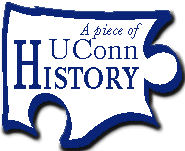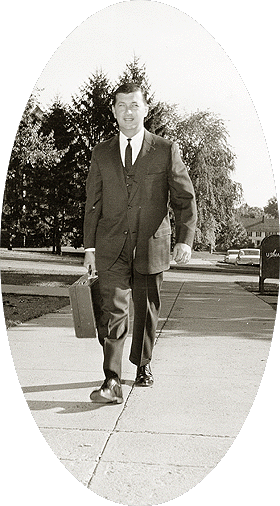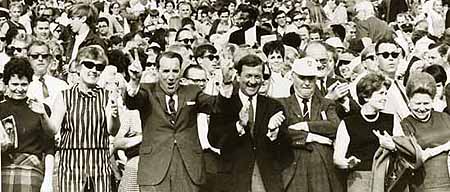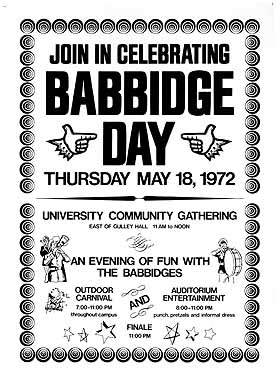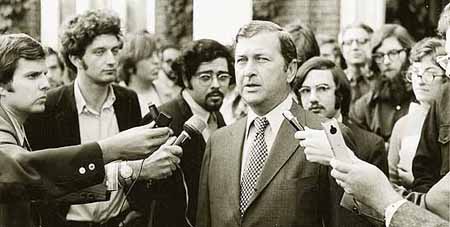|
This is an archived article.
For the latest news, go to the
Advance Homepage For more archives, go to the Advance Archive/Search Page. | ||||||||||
|
Babbidge Ushered in 'Era of Good Feelings'
"Hello. This is Mr. Moreland's secretary."
The voice was unmistakable to University faculty or staff calling Wallace Moreland, Class of 1928, assistant to UConn's president. And it would throw them off a beat. The voice at the other end of the telephone was that of Homer Babbidge - Moreland's boss - playing another joke on an innocent caller. Babbidge was known for his humor. He was also known for his devotion to public higher education. And, in his self-deprecating style, Babbidge would note that many viewed him as a "warm athletic supporter." But he was no joke - or jock. Babbidge, UConn's president from 1962-1972, was born May 18, 1925 in Newton, Mass. Just before the Stock Market crash in 1929, his family moved to New Haven, where he began his early schooling. Attending high school in Amherst, N.Y., he returned to New Haven to earn a bachelor's degree at Yale in 1945. He would later earn two more degrees and an honorary doctorate from Yale, and in his initial post-UConn years he returned to New Haven to head Yale's Timothy Dwight College. In the mid-1950s he went to Washington, D.C., as assistant to the U.S. Education Commissioner, becoming assistant to the secretary of the then-new Department of Health, Education and Welfare in 1957. He also was assistant U.S. commissioner of education and director of the Division of Higher Education for two years from 1959. In 1961, when he left H.E.W. to become vice president of the American Council on Education, he received the federal department's Distinguished Service Medal. His time at ACE was limited to one year, however, because in 1962 he fulfilled a long-held dream of returning to the Nutmeg State by becoming the eighth president of the University of Connecticut. The man he replaced, 63 year-old Albert N. Jorgensen, had been president for 27 years. Jorgensen, appointed president in 1935, had taken a small state college of just over 800 students into the modern era, transforming it into a major public research University that had more than 12,000 students when he stepped down in 1962. But during the 1950s, when student enrollment soared by 60 percent, the number of faculty grew by only 36 percent. And in the closing years of the Jorgensen era, younger faculty began to view Jorgensen as out of step. His influence with the legislature was also waning. Clashes with faculty increased, as did criticism from Hartford. Homer Babbidge, in his first convocation address as president to incoming freshmen, promised to usher in a new "era of good feelings." At the end of his 10 years - when he too was clashing more and more with Hartford - it was clear he succeeded. From 1962 to 1972, the number of faculty doubled to more than 1,300. Salaries - an important tool for recruiting new faculty - more than doubled: pay that ranged from $6,588 for an instructor to $11,420 for a full professor in 1962 rose to $11,600 and $24,900 respectively by 1971. Another Babbidge priority was the University library. Then housed in the Wilbur Cross Building, the library had 270,000 volumes when Babbidge began his tenure as president. It acquired its one millionth volume toward the end of 1970, and by then plans were underway for construction of a new library building to handle future expansion of the collections.
Many new academic departments and programs came about during the Babbidge years, as physical growth entered a slower, more controlled phase: bio-behavioral science, genetics, metallurgy, oral history, anthropology, sociology, linguistics and foreign languages. And interdepartmental programs emerged in materials science, nutritional science, marine sciences, water resources, medieval studies, urban studies, Italian studies, black studies, tropical studies, and social science. Some have since been reorganized, merged into other programs, or renamed, but they are all part of the legacy of the Babbidge years. So are the Honors Program, the William Benton Museum of Art, the University of Connecticut Foundation, the regional campuses in Torrington and at Avery Point in Groton, and the arboretum in Stamford. Not all was rosy, of course. It was Babbidge who faced student protests against the Vietnam War and race discrimination, as well as a student strike that followed the killings of four students by National Guardsmen at Kent State University in 1970. He faced difficult decisions regarding on-campus recruiting by companies that manufactured munitions for the war; and he was reviled for allowing state police to handle student rioting.
Yet throughout the confrontations, Babbidge held on to his popularity with the majority of the student body. And in 1972, halfway through his final year, Babbidge's birthday in May was celebrated as "Babbidge Day," with blue and white decals, balloons and a huge cake provided by a student body that begged him, unsuccessfully, to remain as president. Throughout his tenure, Babbidge was a staunch supporter of public education, and he continually fought proposals to impose tuition on students. In an address to the Norwich Jaycees on Jan. 26, 1963 - just four months after becoming president - he outlined reasons why he thought the state should not implement a then-proposed tuition bill: "I would argue that there is no logical ground for charging tuition in a public college or university that is not an equally valid argument for charging tuition in a public high school or elementary school (I said logical not practical). I would also argue that persons educated at public expense at the University of Connecticut will, over the years, pay in taxes on their increased earnings far more than the public invests in their education, I would argue that since the whole state benefits from educating each of our graduates, the whole state can properly share in the cost of educating that student. "And I would most certainly argue that raising the financial threshold of college attendance would serve to impede the purpose of public education - namely, to encourage the individual, regardless of the accidents of birth and economic circumstances, to develop his talents to the fullest." Ultimately, he lost the battle over tuition, and although he denied that his battles with then-Gov. Thomas Meskill over that and other higher education matters had anything to do with his decision, Babbidge announced his resignation in late 1971. In announcing that he would leave the following October, Babbidge said he had accomplished all the goals he had set for the state's flagship university, and was ready to move on. Among his next steps would be a run for the Democratic Party's gubernatorial nomination in 1974 - but he lost to long-time Secretary of the State Ella Grasso, the ultimate winner of the office.
Babbidge became head of Yale's Timothy Dwight College and, later, the Hartford Graduate Center, but his love of UConn never waned. In the early 1980s, he worked with Connecticut Public Television to produce a documentary series on the history of the University, called "The Storrs Story." Babbidge died in 1984, just a short time after receiving a University Medal. And later, the planned new library, completed in 1978, would be named for UConn's eighth president. Mark J. Roy |
